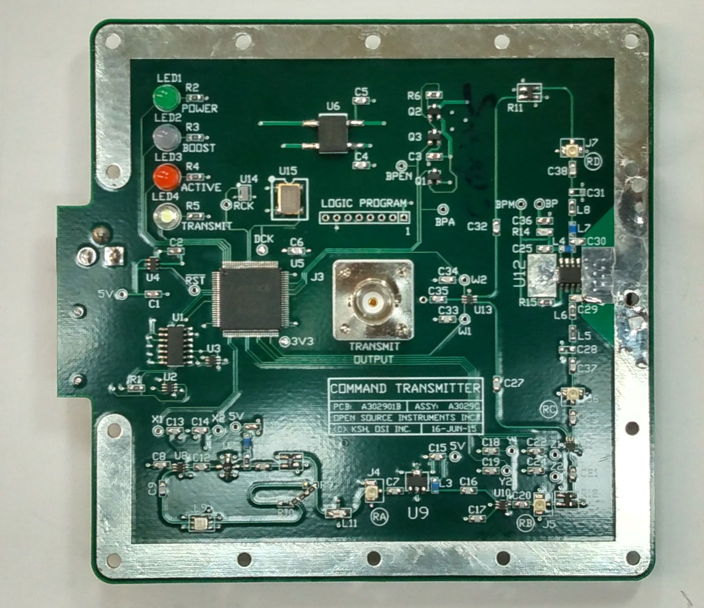Command Transmitter (A3029)
© 2014-2025 Kevan Hashemi,
Open Source Instruments Inc.
Contents
Description
[21-SEP-25] The Command Transmitter (A3029) is a 1-W, 50-Ω, on-off modulated radio-frequency transmitter with a BNC socket for a transmit antenna. The A3029C produces roughly 910 MHz and is designed to transmit commands to our Implantable Stimulator-Transponders (PHP) by means of one of our Damped Loop Antennas (A3015C). Since the summer of 2024, the A3029C is no longer in production at OSI, although we have a few left on the shelf. The A3029C has been replaced by the TCB-B!6, which provides sixteen command transmitters that are integrated with telemetry reception so that a single antenna can be used for both telemetry reception and command transmission.

Figure: 910-MHz Command Transmitter (A3029C) in Enclosure. We see the LWDAQ root cable and 24-V boost power entering on the left. Output power on the BNC socket is 1 W. A Loop Antenna (A3015C) provides omnidirectional transmission for Implantable Stimulator-Transponders (ISTs). There are four indicator lamps: Logic Power (green), Boost Power (blue), Active (amber), and Transmit (white).
The A3029 can operate from the LWDAQ power supplies alone, in which case it produces its non-boost power output. The non-boost output is +24 dBm (240 mW). With a 24-V, 500 mA boost power supply connected, output power increases to +30 dBm (1 W). For the boost power we can use an adaptor like the CENB1010A2403F01. The power adaptor must deliver 10 W at 18-36 V on a 5.5-mm power plug. The connector can be wired with either polarity. With or without boost power, the A3029 output is unconditionally stable.

Figure: 910-MHz Command Transmitter (A3029C) Circuit, Top Side. Made with A302901B PCB. For bottom side with DC-DC converter and connectors see here.
The Transmit lamp turns on only when the antenna output is generating command power. The Activity lamp turns on when the A3029 is exercising some communication or stimulation function, even when it is waiting to transmit command power. The LWDAQ Power lamp indicates that power is being delivered by the LWDAQ cable. The Boost Power lamp indicates the boost power is available. The A3029A, A3029B, A3029C, and A3029F transmit commands according to the command transmission protocol we defined for the Implantable Sensor with Lamp (A3030A).
| Version |
Oscillator
Type |
Frequency (MHz) |
Non-Boost
Power (W) |
Boost
Power (W) |
| A3029A |
Crystal |
146.000 MHz |
60 mW |
1.0 W |
| A3029B |
Crystal |
915.000 MHz |
100 mW |
1.0 W |
| A3029C |
SAW |
910 MHz |
240 mW |
1.0 W |
| A3029F |
None |
None |
None |
None |
Table: Versions of the Command Transmitter (A3029). The A3029F is a repurposing of the logic on the A3029 for command transmission over a wired serial interface.
The A3029 uses a fixed-frequency oscillator to produce its output frequency. We cannot sweep the oscillator frequency. We can, however, inject power from a radio-frequency sweep into the intermediate and power amplifiers so as to measure their frequency response and adjust their matching networks. We use the Command Transmitter (A3023CT) to produce sweep frequency around 146 MHz and the Modulating Transmitter (A3014MT) for sweeps around 915 MHz. The A3029 radio-frequency amplifier consists of two stages and four switches. The switches perform on-off modulation and select automatically between the boost and non-boost output depending upon whether we have the 24-V boost power connected.
Firmware Versions
[22-SEP-25] Firmware version P3029C01.abl configures the A3029C as a command transmitter for Implantable Stimulator-Transponders (IST). The A3029C provides three operations through LWDAQ commands. The rf_on operation turns on the RF power continuously. Send LWDAQ command 0x0081 to the A3029C using the Diagnosti Instrument and you will see the transmit indicator turn on and stay on. The rf_off operation turns off continuous RF power. We send 0x0000 or 0080 to turn off the RF power. The rf_xmit operation transmits the upper eight command bits as a serial byte using the ISL command transmission protocol. We execute this operation by sending LWDAQ command 0xXX82, where "XX" is the hexadecimal representation of the eight-bit value we want to transmit. We describe the transmission protocol here. The bit period is 8192 bits/s, with ten bits being used for each byte transmission. A start bit of 1 is followed by the eight data bits, then a stop bit of 0. At the end of the transmission, the RF power remains off until another command to turn it on is issued. Even if the RF power were turned on continuously before the byte transmission, it remains off afterwards, but boost power will remain connected to the 1-W amplifier unless we follow with a shut-down command 0x0000. The Command Alternator Toolmaker script shows how we can use LWDAQ commands to pulse the A3029C output power with 50% duty cycle for interference testing.
Firmware version P3029F01.abl re-purposes the A3029 for command transmission using X1 as the outgoing carrier rather than radio frequency bursts. The A3029F is deployed in the Direct Fiber Positioning System (DFPS) prototypes. All RF amplifiers are disabled. We remove their current delivery inductors and resistors. Current consumption is 27 mA from +5 V and 0 mA from ±15 V.
Firmware version P3029G01.abl repurposes the A3029 as a continuous source of 1-W RF power for interference testing. The A3029G is for electromagnetic interference testing. In the A3029G, we wire the boost power VB to +5V and do not connect a LWDAQ cable, so as to create a stand-alone, continuous power radiator.
Design and Development
[21-SEP-25] For design files and development logbook, see the A3029 design and development page at D3029.

